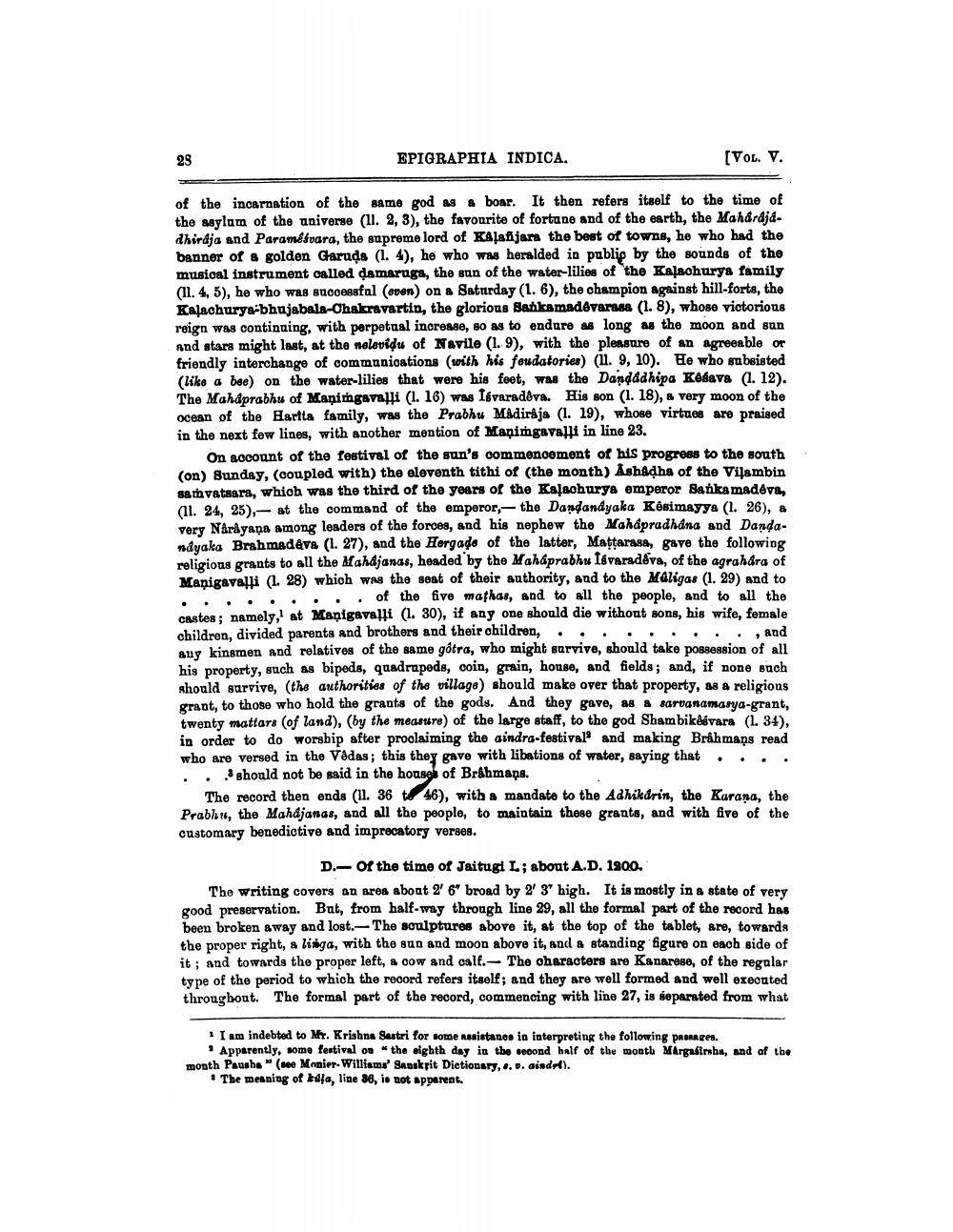________________
23
EPIGRAPHIA INDICA.
(VOL. V.
of the incarnation of the samo god as & boar. It then refers itself to the time of the asylum of the universe (II. 2, 3), the favourite of fortane and of the earth, the Mahardjd. dhirdja and Paramétvara, the supreme lord of Kalajara the best of towns, he who had the banner of a golden Garuda (1. 4), he who was heralded in public by the sounds of the musical instrument oalled damaruga, the son of the water-lilies of the Kalaohurya family (11. 4, 5), he who was successful (even) on a Saturday (1. 6), the champion against hill-forts, the Kalachurya-bhujabala-Ohakravartin, the glorious Sankamadevarasa (1.8), whose victorious reign was continuing, with perpetual increase, so as to endure as long as the moon and sun and stars might last, at the nolovidu of Navile (1. 9), with the pleasure of an agreeable or friendly interchange of communications with his feudatories) (11. 9, 10). He who subsisted (like a bee) on the water-lilies that were his feet, was the Dandadhipa Kedava (1. 12). The Maháprabhu of Manimgavalli (1. 16) was Isvaradeva. His son (1. 18), a very moon of the ocean of the Harita family, was the Prabhu Madiraja (1. 19), whose virtues are praised in the next few lines, with another mention of Maņingavalli in line 23.
On account of the festival of the sun's commencement of his progress to the south (on) Sunday, (coupled with) the eleventh tithi of the month) Ashadhs of the Vilambin sa ta vatsara, which was the third of the years of the Kalachurya emperor Bahkamadeva, (1l. 24, 25), at the command of the emperor,- the Dandandyaka Kosimayya (1. 26), a very Narayana among leaders of the forces, and his nephew the Mahápradhana and Dandandyaka Brahmadava (1. 27), and the Horgade of the latter, Mattarasa, gave the following religions grants to all the Mahajanas, headed by the Maháprabhu Isvarad&va, of the agrahara of Manigavalli (1.28) which was the seat of their authority, and to the Maligas (1.29) and to . . . . . . . . . of the five mafhas, and to all the people, and to all the caster; namely, at Manigavalli (1. 30), if any one should die without sons, his wife, female children, divided parents and brothers and their children, . . . . . . . . ., and auy kinsmen and relatives of the same gôtra, who might survive, should take possession of all his property, such as bipeda, quadrupeds, coin, grain, house, and fields; and, if none such should survive, (the authorities of the village) should make over that property, as a religious grant, to those who hold the grants of the gods. And they gave, as a saruanamasya-grant, twenty mattars (of land), (by the meastire) of the large staff, to the god Shambikdsvara (1. 34), in order to do worship after proclaiming the aindra-festival and making Brahmans read who are versed in the Vedas; this they gave with libations of water, saying that . . . . . .. should not be said in the house of Brahmans.
The record then ends (11. 36 46), with a mandate to the Adhikarin, the Karana, the Prabh 16, the Mahdjangs, and all the people, to maintain these grants, and with five of the customary benedictive and imprecatory verses.
D.- or the time of Jaitugi L; about A.D. 1900. The writing covers an area aboat 2' 6" broad by 2' 3' high. It is mostly in a state of very good preservation. Bat, from half-way through line 29, all the formal part of the record has been broken away and lost. The sculptures above it, at the top of the tablet, are, towards the proper right, a linga, with the sun and moon above it, and a standing figure on each side of it; and towards the proper left, a cow and calf. The characters are Kanarese, of the regular type of the period to which the record refers itself; and they are well formed and well exeonted througbout. The formal part of the record, commencing with line 27, is separated from what
* I am indebted to Mr. Krishna Sastri for some assistano in interpreting the following pages.
. Apparently, some festival on the sigbth day in the second half of the month Margairahs, and of the month Pausha" (see Monier-Williams' Sanskrit Dictionary, ... aindet).
The meaning of da, line 36, is not apparent.




